“Don Patrol” by Joe Archibald
“HAW-W-W-W-W!†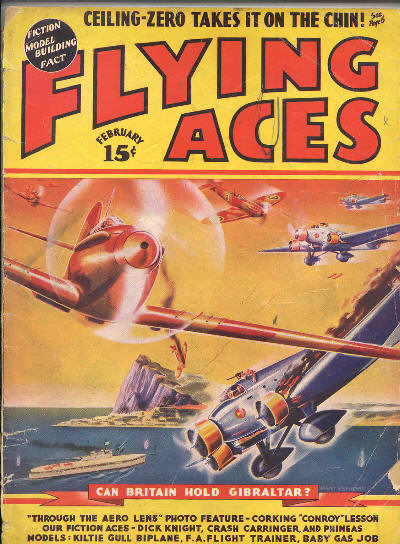 That sound can only mean one thing—that Bachelor of Artifice, Knight of Calamity and an alumnus of Doctor Merlin’s Camelot College for Conjurors is back to vex not only the Germans, but the Americans—the Ninth Pursuit Squadron in particular—as well. Yes it’s the marvel from Boonetown, Iowa himself—Lieutenant Phineas Pinkham!
That sound can only mean one thing—that Bachelor of Artifice, Knight of Calamity and an alumnus of Doctor Merlin’s Camelot College for Conjurors is back to vex not only the Germans, but the Americans—the Ninth Pursuit Squadron in particular—as well. Yes it’s the marvel from Boonetown, Iowa himself—Lieutenant Phineas Pinkham!
We’re back to Pinkham’s exploits in The Great Guerre where G-2 calls on Pinkham to go undercover in Spain to keep the Germans from getting their hands on the secret plans for the Alhambra and a foothold in France’s backdoor.
Down in the Kingdom of Alphonso, certain cagey Castilians had cooked up a Spanish omelet for the Allies—one which had a Kraut smell to it. And when the bad eggs that figured in it evaded all the Entente spies, the Democrat Generals were frantic. But the real action didn’t begin until Don Quixote Pinkhamo homed his way into the land of bull fights—and it didn’t stop until the terrible tempered Ferdinando horned him right out again.
“A Hunting We Will Go” by Joe Archibald
“HAW-W-W-W-W!†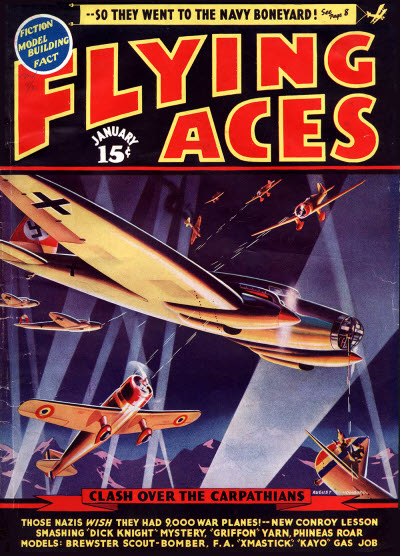 That sound can only mean one thing—that Bachelor of Artifice, Knight of Calamity and an alumnus of Doctor Merlin’s Camelot College for Conjurors is back to vex not only the Germans, but the Americans—the Ninth Pursuit Squadron in particular—as well. Yes it’s the marvel from Boonetown, Iowa himself—Lieutenant Phineas Pinkham!
That sound can only mean one thing—that Bachelor of Artifice, Knight of Calamity and an alumnus of Doctor Merlin’s Camelot College for Conjurors is back to vex not only the Germans, but the Americans—the Ninth Pursuit Squadron in particular—as well. Yes it’s the marvel from Boonetown, Iowa himself—Lieutenant Phineas Pinkham!
In 1918, Lieutenant Phineas “Carbuncle†Pinkham took a long hop, figuratively speaking, in an astral plane and came down to earth with the Zodiac in his lap. And as if that weren’t enough, a spiritualist of note—one Madame Mazola, who had taken a powder out of the Tyrol in 1915—put out her shingle in Bar-le-Duc, announcing to whomever it might concern that she would give an applicant a clear wire to his relatives who had long since departed this vale of tears. Ectoplasm was her specialty, and it would be produced for the most skeptical—for the insignificant sum of five francs—payable in advance!
After Madame Mazola hit town with her astrology, it didn’t take Phineas “Taurus†Pinkham long to prove that Garrity was a crab, Gillis was a sucker, Goomer was two other guys, and Casey was the goat. But it wasn’t until Babette hit Phineas with her skillet that the transplanted star gazer from Boonetown really got his astral plane into the ascendancy. And then he hit into something himself—a double-talk play!
J.W. Scott’s Sky Devils, Pt3

WE’RE back with two more of Scott’s great covers! Scott painted covers for practically every genre of pulp—sports, western, detective, science fiction and aviation. Most notable of his aviation covers are the ones he did for Western Fiction Publishing’s Sky Devils, which only ran for seven issues. Scott was very adept at capturing people, so his aviation covers center on the pilots and gunners in the planes rather than the planes themselves for the most part. The issues contained no stories for these covers like other titles we’ve featured, but Scott’s magnificent work was just too good to not share! And besides, he captures the action so well, you can imagine the story that goes with the cover he’s painted.
Here are the next two covers Scott did for Sky Devils—the April and June 1939 issues!

Sky Devils, April 1939 by J.W. Scott

Sky Devils, June 1939 by J.W. Scott
Check out David Saunder’s page for J.W. Scott at his excellent Field Guide to Wild American Pulp Artists site for more great examples of Scott’s work. And check back in two weeks for Scott’s final cover for Sky Devils magazine!
J.W. Scott’s Sky Devils, Pt2

WE’RE back with two more of Scott’s great covers! Scott painted covers for practically every genre of pulp—sports, western, detective, science fiction and aviation. Most notable of his aviation covers are the ones he did for Western Fiction Publishing’s Sky Devils, which only ran for seven issues. Scott was very adept at capturing people, so his aviation covers center on the pilots and gunners in the planes rather than the planes themselves for the most part. The issues contained no stories for these covers like other titles we’ve featured, but Scott’s magnificent work was just too good to not share! And besides, he captures the action so well, you can imagine the story that goes with the cover he’s painted.
Here are the next two covers Scott did for Sky Devils—the October 1938 and January 1939 issues!

Sky Devils, October 1938 by J.W. Scott

Sky Devils, January 1939 by J.W. Scott
Check out David Saunder’s page for J.W. Scott at his excellent Field Guide to Wild American Pulp Artists site for more great examples of Scott’s work. And check back in two weeks for two more of Scott’s covers for Sky Devils magazine!
“The Fangs of Otan” by Harold F. Cruickshank
WE’RE celebrating the works of 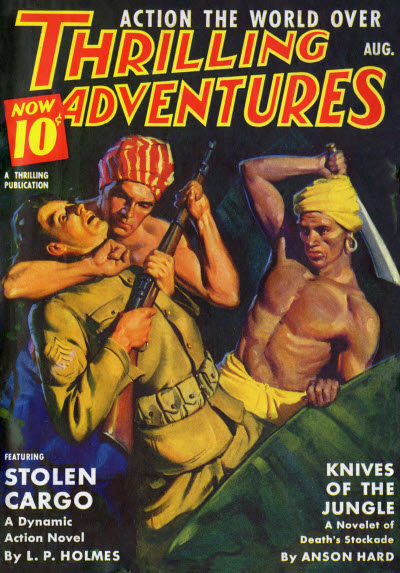 Canada’s very own Harold F. Cruickshank this month. As the winds of war swept across Europe, Cruickshank continued to crank out aviation stories for the pulps, but he also started to write animal stories. These stories proved to be very popular in the pages of western and adventure magazines.
Canada’s very own Harold F. Cruickshank this month. As the winds of war swept across Europe, Cruickshank continued to crank out aviation stories for the pulps, but he also started to write animal stories. These stories proved to be very popular in the pages of western and adventure magazines.
Otan, a proud she-cougar, fights to save her precious liter of three cubs from the likes of Yeepek, a great bald eagle, and Mishi, a sour-tempered old barren she-grizzly! From the August 1939 Thrilling Adventures, it’s “The Fangs of Otan!”
A She-Cougar Fights for Life and Safety in the Untracked Wilds!
“Wings of the Brave” by Harold F. Cruickshank
SKY DEVIL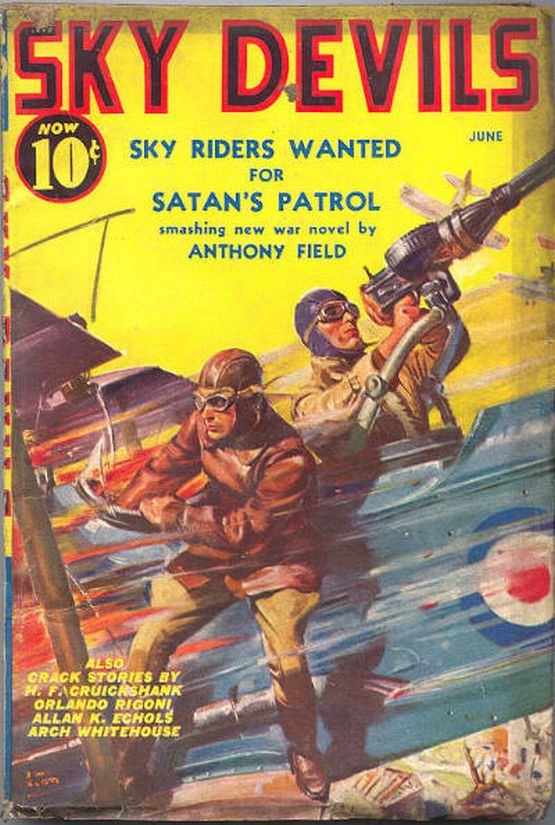 flew through the Hell Skies of 29 adventures in the pages of Dare-Devil Aces from 1932-1935. Cruickshank returned to the savior of the Western Front in six subsequent stories several years later. The first two were in the pages of Sky Devils (June 1939) and Fighting Aces (March 1940). The other four ran in Sky Fighters (1943-1946); and like Oppenheim had done with his Three Mosquitoes, so Cruickshank did with Sky Devil—he moved him to the Second World War where Bill Dawe changes his name to get into the air service and flys along side his son!
flew through the Hell Skies of 29 adventures in the pages of Dare-Devil Aces from 1932-1935. Cruickshank returned to the savior of the Western Front in six subsequent stories several years later. The first two were in the pages of Sky Devils (June 1939) and Fighting Aces (March 1940). The other four ran in Sky Fighters (1943-1946); and like Oppenheim had done with his Three Mosquitoes, so Cruickshank did with Sky Devil—he moved him to the Second World War where Bill Dawe changes his name to get into the air service and flys along side his son!
Here we have Sky Devil’s first appearance after his run in Dare-Devil Aces in the pages of the aptly named Sky Devils. Bill Dawe works a hunch as only he can that an old chateau that is supposedly neutral ground between the Allies and the Boche is actually a front for German forces! From June 1939 it’s “Wings of the Brave!”
This wasn’t the ordinary flame of Spandau Fire menacing the American Sky Devil’s tail—but the fearsome blaze of the Baron Von Ryter’s world-famous battle insignia!

For more great tales 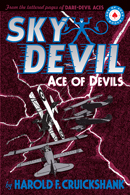 of Sky Devil and his Brood by Harold F. Cruickshank, check out our new volume of his collected adventures in Sky Devil: Ace of Devils—Nowhere along the Western Front could you find a more feared crew, both in their element and out. The Sky Devil and his Brood could always be counted on to whip Germany’s best Aces, out-scrap entire squadrons of Boche killers, or tackle not one, but two crazed Barons with an Egyptology fetish! But what happens when they find themselves up in a dirigible fighting a fleet of ghost zeppelins, or down in the English Channel battling ferocious deep water beasts, or even behind enemy lines dealing with a crazed Major Petrie? Plenty, and you can read it all here! Pick up your copy today at all the usual outlets—Adventure House, Mike Chomko Books and Amazon!
of Sky Devil and his Brood by Harold F. Cruickshank, check out our new volume of his collected adventures in Sky Devil: Ace of Devils—Nowhere along the Western Front could you find a more feared crew, both in their element and out. The Sky Devil and his Brood could always be counted on to whip Germany’s best Aces, out-scrap entire squadrons of Boche killers, or tackle not one, but two crazed Barons with an Egyptology fetish! But what happens when they find themselves up in a dirigible fighting a fleet of ghost zeppelins, or down in the English Channel battling ferocious deep water beasts, or even behind enemy lines dealing with a crazed Major Petrie? Plenty, and you can read it all here! Pick up your copy today at all the usual outlets—Adventure House, Mike Chomko Books and Amazon!

“They Had What It Takes – Part 35: Major Fred Lord†by Alden McWilliams
Alden McWilliams’ illustrated tributes 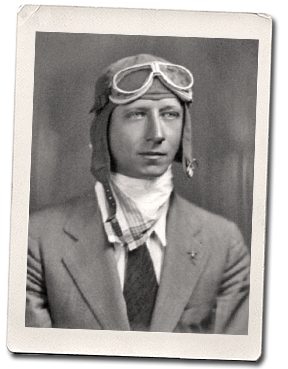 to the pioneer fliers of the early days of aviation ran in Flying Aces from 1937 through 1940. McWilliam’s bio-graphical sketch for the December 1939 issue was Major Frederic Ives Lord—a real life version of Chinese Brady! A self-described soldier for hire, Major Lord flew in five different wars: The First World War, The Russian Cival War, The Mexican Revolution, The Spanish Cival War, and The Second World War.
to the pioneer fliers of the early days of aviation ran in Flying Aces from 1937 through 1940. McWilliam’s bio-graphical sketch for the December 1939 issue was Major Frederic Ives Lord—a real life version of Chinese Brady! A self-described soldier for hire, Major Lord flew in five different wars: The First World War, The Russian Cival War, The Mexican Revolution, The Spanish Cival War, and The Second World War.
According to his wikipedia entry, Major Lord was a keen writer, often chronicalling his exploits. A number of these appeared in Flying Aces while his unpublished papers are held in the archives of the Rabb Collection along with hundreds of photographes of Lord frequently with his plane. Lord even “approached movie production companies in the hopes that his story would be turned into a feature film.”
He lived to the age of 70 when he was killed by a vagrant in Apple Valley, California in 1967.
“They Had What It Takes – Part 34: Clarence Chamberlin†by Alden McWilliams
Alden McWilliams’ illustrated tribute to the 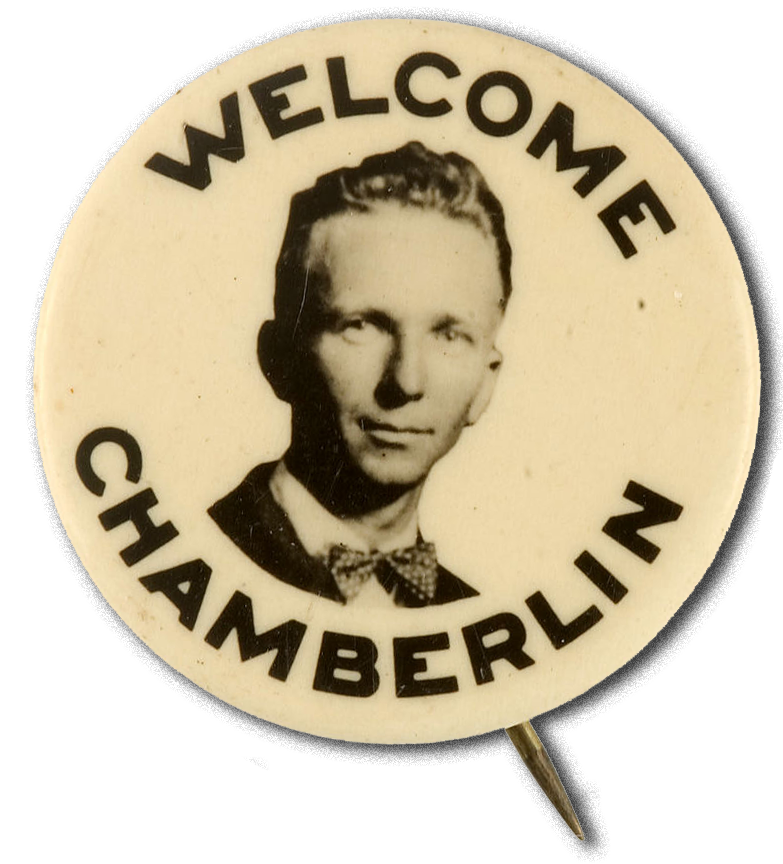 pioneer fliers of the early days of aviation was called “They Had What it Takesâ€, and this week we bring you the 34th installment, which appeared in the November 1939 Flying Aces. . In this week’s installment McWilliams brings his talents to rendering the life of that Trans-Atlantic vet, Clarence Chamberlin.
pioneer fliers of the early days of aviation was called “They Had What it Takesâ€, and this week we bring you the 34th installment, which appeared in the November 1939 Flying Aces. . In this week’s installment McWilliams brings his talents to rendering the life of that Trans-Atlantic vet, Clarence Chamberlin.
Clarence Chamberlin just missed out on being the household name that Lindbergh became. When Lindbergh took off, the plane’s owner Levine was still tinkering with the plane and arguing with who would pilot it—thus preventing Chamberlin from becoming the first to fly solo across the Atlantic. However, several weeks later, Chamberlin took off with Levine as a passenger and became the second man to pilot a fixed wing aircraft across the Atlantic to the European mainland, but the first to take a passenger! And he flew further setting a distance record, landing in Eisleben, Germany when he ran out of gas—just 110 miles short of his goal of Berlin.
“They Had What It Takes – Part 33: Arch Whitehouse†by Alden McWilliams
This week we bring you Part 33 of 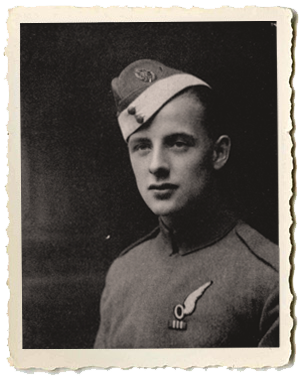 Alden McWilliams’ illustrated tribute to the pioneer fliers of the early days of aviation. He called it “They Had What it Takes†and this installment appeared in the October 1939 Flying Aces. It features our old pal here at Age of Aces—Arch Whitehouse. Whitehouse was a prolific writer, both for the pulps and aviation-themed books after the pulps ended. We’ve posted a number of Whitehouse’s stories from Flying Aces and Sky Birds with some of his long running characters like Buzz Benson, Crash Carringer, Coffin Kirk, The Casket Crew, Tug Hardwick and The Griffon!
Alden McWilliams’ illustrated tribute to the pioneer fliers of the early days of aviation. He called it “They Had What it Takes†and this installment appeared in the October 1939 Flying Aces. It features our old pal here at Age of Aces—Arch Whitehouse. Whitehouse was a prolific writer, both for the pulps and aviation-themed books after the pulps ended. We’ve posted a number of Whitehouse’s stories from Flying Aces and Sky Birds with some of his long running characters like Buzz Benson, Crash Carringer, Coffin Kirk, The Casket Crew, Tug Hardwick and The Griffon!
Arch Whitehouse was blessed with a fertile imagination which seemed to spill over into the acounts of his own war record. McWilliams piece and Whitehouse’s own biography, Hell in Helmets, credit Whitehouse with shooting down 16 German aeroplanes—at most he may have had 4 kills—it seems that he was something of a serial exaggerator.
We’ve posted this installment long before we started posting the entire series of Alden McWilliam’s “They Had What It Takes”, but here it is in sequence in case you missed it.
Next time: Clarence Chamberlin—Trans-Atlantic Vet.
“They Had What It Takes – Part 32: “Casey” Jones†by Alden McWilliams
Age of Aces presents the thirty-second installment of Alden McWilliams’ illustrated tribute to the pioneer fliers of the early days of aviation. This week McWilliams chronicles the life and contributions to aviation of aero booster No.1—Charles S. “Casey” Jones. Jones, a veteran of the hell skies of WWI, would rise to prominance as one of the great air racers of his time. He used his popularity to sell the American public on aviation, contributing to radio shows and having columns in two leading aviation magazines—”Flying Colors” in Air Adventures (1928-29) and “Casey Jones’ Flying Course” in Sky Birds (1933-34).
In 1932 he founded the Casey Jones School of Aeronautics along with Lee D. Warrender and George A. Vaughn Jr. The school went through a number on name changes, the most recent was in 2004 when it was remamed after Vaughn.
Casey passed away in February 1976.
“They Had What It Takes – Part 31: Charles E. Rosendahl†by Alden McWilliams
In the late thirties Flying Aces ran Alden McWilliams’ monthly illustrated tribute to the pioneer fliers of the early days of aviation which was called They Had What it Takes. In the August 1939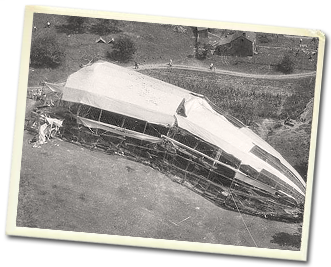 issue they featured American Air Ship Ace Charles E. Rosendahl!
issue they featured American Air Ship Ace Charles E. Rosendahl!
Rosendahl started his Naval career aboard battleships and moved into rigid airship duty after the Navy’s Bureau of Navigation circulated a letter asking for volunteers. He distinguished himself by successfully bringing the bow section of the the dirigible Shenandoah after she broke apart in the air! He rose through the ranks serving aboard a number of lighter-than-air craft. Eventually achieving the rank of Vice Admiral in the US Navy, Rosendahl never stopped advocating the virtues of lighter-than-air flight writing several books about them (his papers are archived in the McDermott Library at The University of Texas at Dallas) and was aboard the N class blimp ZPG-3W on its final flight in August 1962 when the US Navy ended airship operations. Rosendahl passed away in May 1977.
“They Had What It Takes – Part 30: Lee Gehlbach†by Alden McWilliams
This week we bring you Part 30 of Alden McWilliams’ illustrated tribute to the pioneer fliers of the early days of aviation. He called it “They Had What it Takes†and this installment appeared in the July 1939 Flying Aces. It features that top-flight test pilot Lee Gehlbach.
In 1935, Time Magazine described him as “a leader in his highly hazardous profession at 32, Lee Gehlbach became an aeronautical engineer because he was “a farmer’s son who couldn’t get used to getting up at 4 in the morning.” Graduated from the University of Illinois in 1924, he enlisted in the Army Air Corps, resigned five years later to become a free-lance pilot and consultant. Best known as a racing pilot, he won first place and $15,000 in the 5,541-mi. All-America Flying Derby of 1930, beating such famed speed merchants as the late Lowell Bayles and Jimmy Wedell.”
Here Gehlbach tests out the Grumman F3F-2 “Flying Barrel.”
“They Had What It Takes – Part 29: Ernst Udet” by Alden McWilliams
This week we bring you Part 29 of Alden McWilliams’ illustrated tribute to the pioneer fliers of the early days of aviation. He called it “They Had What it Takes†and this installment appeared in the June 1939 Flying Aces. It features that Ace of The Black Cross, Ernst Udet. Udet was the highest scoring Ace to survive the Great War. With 62 victories he was second only to his commander in the Flying Circus, Manfred von Richthofen.
“They Had What It Takes – Part 28: Roscoe Turner” by Alden McWilliams
In the late thirties Flying Aces ran 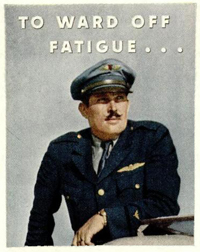 Alden McWilliams’ monthly illustrated tribute to the pioneer fliers of the early days of aviation which was called “They Had What it Takesâ€. In the May 1939 issue they featured the “dashing racing Ace” Roscoe Turner! Roscoe learned to fly during WWI and started barnstorming in the 20’s which led into air racing. A triple winner of the Thompson Trophy, Turner was sponsored by the Gilmore Oil Company who provided him with a lion cub named “Gilmore” (complete with his own cub-sized parachute) for publicity reasons. Turner frequently took Gilmore on tour with him.
Alden McWilliams’ monthly illustrated tribute to the pioneer fliers of the early days of aviation which was called “They Had What it Takesâ€. In the May 1939 issue they featured the “dashing racing Ace” Roscoe Turner! Roscoe learned to fly during WWI and started barnstorming in the 20’s which led into air racing. A triple winner of the Thompson Trophy, Turner was sponsored by the Gilmore Oil Company who provided him with a lion cub named “Gilmore” (complete with his own cub-sized parachute) for publicity reasons. Turner frequently took Gilmore on tour with him.
“They Had What It Takes – Part 27: C. P. T. Ulm” by Alden McWilliams
Starting with the February 1937 issue of Flying Aces, 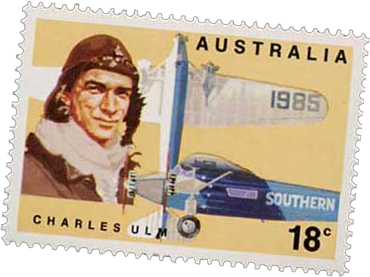 Alden McWilliams began his illustrated tribute to the pioneer aviators of that era. He called it “They Had What it Takesâ€. It appeared in each issue of Flying Aces until June 1940. Part 27 apeared in the April 1939 issue and featured Another great Austrailian Air Pioneer—Charles Thomas Philippe Ulm!
Alden McWilliams began his illustrated tribute to the pioneer aviators of that era. He called it “They Had What it Takesâ€. It appeared in each issue of Flying Aces until June 1940. Part 27 apeared in the April 1939 issue and featured Another great Austrailian Air Pioneer—Charles Thomas Philippe Ulm!
Ulm is probably best known for his association with Sir Charles Kingsford-Smith who was covered by McWilliams two years earlier. He was Kingsford-Smith’s copilot on many of his famous flights including the 1928 first crossing of the Pacific in the Southern Cross. And together they founded Austrailian National Airways.
 That sound can only mean one thing—that Bachelor of Artifice, Knight of Calamity and an alumnus of Doctor Merlin’s Camelot College for Conjurors is back to vex not only the Germans, but the Americans—the Ninth Pursuit Squadron in particular—as well. Yes it’s the marvel from Boonetown, Iowa himself—Lieutenant Phineas Pinkham!
That sound can only mean one thing—that Bachelor of Artifice, Knight of Calamity and an alumnus of Doctor Merlin’s Camelot College for Conjurors is back to vex not only the Germans, but the Americans—the Ninth Pursuit Squadron in particular—as well. Yes it’s the marvel from Boonetown, Iowa himself—Lieutenant Phineas Pinkham! 




 That sound can only mean one thing—that Bachelor of Artifice, Knight of Calamity and an alumnus of Doctor Merlin’s Camelot College for Conjurors is back to vex not only the Germans, but the Americans—the Ninth Pursuit Squadron in particular—as well. Yes it’s the marvel from Boonetown, Iowa himself—Lieutenant Phineas Pinkham!
That sound can only mean one thing—that Bachelor of Artifice, Knight of Calamity and an alumnus of Doctor Merlin’s Camelot College for Conjurors is back to vex not only the Germans, but the Americans—the Ninth Pursuit Squadron in particular—as well. Yes it’s the marvel from Boonetown, Iowa himself—Lieutenant Phineas Pinkham! 




 Canada’s very own
Canada’s very own  flew through the Hell Skies of 29 adventures in the pages of Dare-Devil Aces from 1932-1935. Cruickshank returned to the savior of the Western Front in six subsequent stories several years later. The first two were in the pages of Sky Devils (June 1939) and Fighting Aces (March 1940). The other four ran in Sky Fighters (1943-1946); and like Oppenheim had done with his Three Mosquitoes, so Cruickshank did with Sky Devil—he moved him to the Second World War where Bill Dawe changes his name to get into the air service and flys along side his son!
flew through the Hell Skies of 29 adventures in the pages of Dare-Devil Aces from 1932-1935. Cruickshank returned to the savior of the Western Front in six subsequent stories several years later. The first two were in the pages of Sky Devils (June 1939) and Fighting Aces (March 1940). The other four ran in Sky Fighters (1943-1946); and like Oppenheim had done with his Three Mosquitoes, so Cruickshank did with Sky Devil—he moved him to the Second World War where Bill Dawe changes his name to get into the air service and flys along side his son! of Sky Devil and his Brood by Harold F. Cruickshank, check out our new volume of his collected adventures in
of Sky Devil and his Brood by Harold F. Cruickshank, check out our new volume of his collected adventures in 
 to the pioneer fliers of the early days of aviation ran in Flying Aces from 1937 through 1940. McWilliam’s bio-graphical sketch for the December 1939 issue was
to the pioneer fliers of the early days of aviation ran in Flying Aces from 1937 through 1940. McWilliam’s bio-graphical sketch for the December 1939 issue was  pioneer fliers of the early days of aviation was called “They Had What it Takesâ€, and this week we bring you the 34th installment, which appeared in the November 1939 Flying Aces. . In this week’s installment McWilliams brings his talents to rendering the life of that Trans-Atlantic vet,
pioneer fliers of the early days of aviation was called “They Had What it Takesâ€, and this week we bring you the 34th installment, which appeared in the November 1939 Flying Aces. . In this week’s installment McWilliams brings his talents to rendering the life of that Trans-Atlantic vet,  Alden McWilliams’ illustrated tribute to the pioneer fliers of the early days of aviation. He called it “They Had What it Takes†and this installment appeared in the October 1939 Flying Aces. It features our old pal here at Age of Aces—
Alden McWilliams’ illustrated tribute to the pioneer fliers of the early days of aviation. He called it “They Had What it Takes†and this installment appeared in the October 1939 Flying Aces. It features our old pal here at Age of Aces—

 Alden McWilliams began his illustrated tribute to the pioneer aviators of that era. He called it “They Had What it Takesâ€. It appeared in each issue of Flying Aces until June 1940. Part 27 apeared in the April 1939 issue and featured Another great Austrailian Air Pioneer—
Alden McWilliams began his illustrated tribute to the pioneer aviators of that era. He called it “They Had What it Takesâ€. It appeared in each issue of Flying Aces until June 1940. Part 27 apeared in the April 1939 issue and featured Another great Austrailian Air Pioneer—